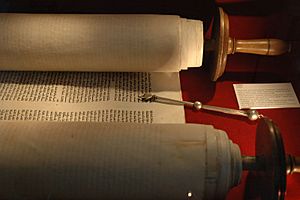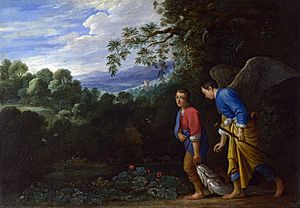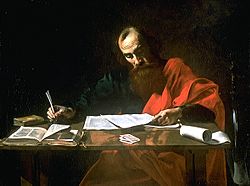Authorship of the Bible facts for kids
There is much discussion today about who wrote the Bible. Most experts believe that many parts of the Bible were written by different people. They also think that these writings were later edited to create the books we read today. This article will explain what most modern experts think, as well as the older, traditional beliefs from Jewish and Christian faiths.
Contents
Who Wrote the Bible?
Traditionally, many religious people believed that God wrote the Torah (the first five books of the Bible) in heaven. They thought that Moses then received it directly from God. Early Christian leaders also believed that the scriptures were inspired or dictated by God. However, they didn't always agree on which writings were truly "scriptural." This is why different Christian groups (like Eastern Orthodox and Roman Catholic churches) include some books (called the Apocrypha) that Protestant churches do not.
In the 20th century, most religious scholars, both Catholic and Protestant, started to move away from the idea that God dictated every word. They began to focus more on the role of the human authors. Because of this, even many conservative scholars now agree that, for example, the Book of Isaiah was written by several authors. They also accept that 2 Corinthians is actually two letters that were later joined together.
The Hebrew Bible
The Hebrew Bible, also known as the Tanakh, is the collection of holy books used in Judaism. These same books, arranged in a slightly different order, also make up the Protestant Old Testament.
The Torah (First Five Books)
The first part of the Jewish Bible is the Torah. This word means "Instruction" or "Law." Scholars often call it the Pentateuch, which means "five scrolls" in Greek. It includes five books: Genesis, Exodus, Leviticus, Numbers, and Deuteronomy. These books are also the first part of every Christian Old Testament.
For a long time, most Jews and Christians believed that Moses wrote all five books of the Torah, except for the last few verses of Deuteronomy, which describe his death. This belief was common until the 1600s. Today, most scholars agree that the Pentateuch was not written by just one person. Instead, they believe it was put together over many centuries.
Genesis, Exodus, Leviticus, and Numbers
Since the late 1800s, many scholars have agreed on the "documentary hypothesis." This idea suggests that the first four books (Genesis, Exodus, Leviticus, Numbers) were created by combining four separate documents. These documents are known as the Jahwist, the Elohist, the Deuteronomist, and the Priestly sources.
While this idea has been updated over time, scholars still widely recognize different writing styles and ideas from the Deuteronomist and Priestly sources. Newer ideas suggest that these books were put together slowly over time, by adding small "fragments" of text, or by adding to a basic text. Most recent ideas suggest that the Pentateuch was completed around the 400s BCE, when Judah was part of the Persian empire.
Deuteronomy
The book of Deuteronomy is often studied separately from Genesis, Exodus, Leviticus, and Numbers. It seems to come from a single main "source." The process of writing this book likely took several hundred years, from the 700s to the 500s BCE.
Scholars believe its authors might have been:
- Prophets (because Deuteronomy shares ideas with prophets like Hosea).
- Levitical priests (because it emphasizes the role of the Levites).
- Wise teachers and scribes (because it values wisdom and is written in a style that scribes would know).
Deuteronomy was later used as the introduction to a large history of Israel, written in the early 500s BCE. Even later, it was separated from that history and used to complete the Pentateuch.
The Prophets
Former Prophets
The Former Prophets (Nevi'im Rishonim) are the first part of the second division of the Hebrew Bible, called the Nevi'im ("Prophets"). In Christian Bibles, the Book of Ruth is placed between Judges and Samuel, but in the Hebrew Bible, Ruth is in a later section.
According to Jewish tradition from the 100s CE, the Book of Joshua was written by Joshua. The Book of Judges and the Books of Samuel were written by the prophet Samuel, with some parts by prophets Gad and Nathan. The two Books of Kings were believed to be written by Jeremiah.
Since 1943, most scholars have accepted Martin Noth's idea that Deuteronomy, Joshua, Judges, Samuel, and Kings are all part of one large work called the "Deuteronomistic history." Noth thought this history was written by one author during the Babylonian exile (586–539 BCE). This author or editor started with an early version of Deuteronomy (written in the late 600s BCE) and then chose, edited, and wrote other parts to create a connected story.
Later, Frank Moore Cross suggested that an earlier version of this history was written in Jerusalem during the time of King Josiah. This first version was then revised and expanded. Even later, scholars found more layers and more authors or editors. In the 1990s, some scholars began to question if a single Deuteronomistic history even existed. So, the origin of these books is still debated.
Latter Prophets
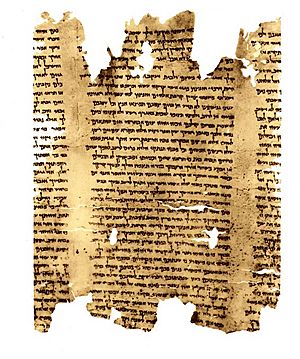
Isaiah
Modern scholars divide the Book of Isaiah into three parts, each with a different origin:
- "First Isaiah" (chapters 1–39): Contains the words of the prophet Isaiah from the 700s BCE, plus later additions by his followers.
- "Deutero-Isaiah" (chapters 40–55): Written by an unknown Jewish author in Babylon near the end of the Babylonian captivity.
- "Trito-Isaiah" (chapters 56–66): Written by unknown followers of Deutero-Isaiah in Jerusalem right after the return from Babylon. (Some scholars think chapters 55–66 were written by Deutero-Isaiah after Babylon fell.)
This neat order of pre-exile, exile, and post-exile material can be a bit misleading. Some scholars note that a lot of editing seems to have happened in all three parts of the book.
Jeremiah
Jeremiah lived in the late 600s and early 500s BCE. The Book of Jeremiah mentions Baruch ben Neriah as the prophet's helper who wrote down his words. Because of this, many people have wondered if Baruch wrote an early version of the book.
In the early 1900s, Sigmund Mowinckel identified three types of material in the book:
- Jeremiah 1–25 (Type A): The actual words of Jeremiah.
- Biographic prose material (Type B): Written by an admirer around 580–480 BCE.
- The rest (Type C): From later periods.
There has been much discussion about Mowinckel's ideas, especially how much of the book is truly from Jeremiah and what role Baruch played. It's generally agreed that the book has strong connections to the Deuteronomistic writings found in the Former Prophets. This idea is similar to the old belief that Jeremiah wrote both his own book and the Books of Kings.
Ezekiel
The Book of Ezekiel says it contains the words of Ezekiel ben-Buzi, a priest living in exile in Babylon between 593 and 571 BCE. However, different copies of the book vary a lot, showing that it has been heavily edited. While Ezekiel himself might have done some of this editing, most scholars agree that the book we have today was put together by a very educated group of priestly writers. This group was loyal to the historical Ezekiel and closely connected to the Temple.
Minor Prophets (Book of the Twelve)
The Minor Prophets are considered one book in the Hebrew Bible. Many scholars agree that this "Book of the Twelve" was edited to become a connected collection. This process is thought to have finished during the Persian period (538–332 BCE), though there's debate about exactly when.
For each individual book, scholars usually assume there's an original core of prophetic teachings that came from the prophet whose name is on the book. The main exception is the Book of Jonah. This is an anonymous work with no prophetic messages, and it was likely written during the Hellenistic period (332–167 BCE).
The Writings
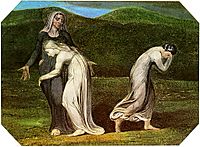
Psalms
Many of the Psalms have titles that seem to name their authors. However, these titles were probably added later to connect the psalms to important figures in tradition. The individual psalms come from very different time periods. Some describe a reigning king and a working Temple, while others clearly mention events from the Exile.
Job
The unknown author of the Book of Job likely wrote it no earlier than the 500s BCE. Most evidence suggests it was written after the Exile. The book has about 1,000 lines, with about 750 forming the original core.
Proverbs
The Book of Proverbs is made up of several collections from different sources. Verses 10:1–22:16 are probably the oldest part. Chapters 1–9 were added as an introduction, though it's debated if this happened before or after the Exile (587 BCE). The other collections were probably added later, with the book reaching its final form around the 200s BCE.
Ruth
The Talmud says that Samuel wrote the Ruth. However, this doesn't fit with some details in the book. Some scholars have suggested that the anonymous author was a woman, or a man who cared deeply about women's issues. The book is mostly a single work, though the family tree of David seems to be a later addition.
Song of Songs (Song of Solomon)
The Song of Songs was traditionally believed to be written by Solomon. However, modern scholars date it to around the 200s BCE. Scholars still debate if it's one complete work (by a single author) or more like a collection of different poems.
Qoheleth/Ecclesiastes
The Book of Ecclesiastes is usually dated to the mid-200s BCE. It was likely written in Jerusalem. The book's claim that Solomon is the author is a literary device; the author also calls himself "Qoheleth," a word with unclear meaning. Critics have understood it as a name, a pen name, an abbreviation, or a role. The author also calls himself a "shepherd," a title usually meaning royalty.
Lamentations
Traditionally, Lamentations is said to be written by the Prophet Jeremiah. However, language and religious ideas suggest it became a separate book in the 200s or 100s BCE. Its contents likely came from special mourning practices in Jewish communities during and after the Exile.
Esther
The Book of Esther was written in the late 300s or early 200s BCE by Jews living in the eastern parts of the Persian empire. It is a short story that uses themes from wisdom literature. Its original sources are still unknown.
Daniel
The Book of Daniel presents itself as the work of a prophet named Daniel who lived in the 500s BCE. However, most modern scholars date it to the 100s BCE. The author, writing during the time of the Maccabees, wanted to assure fellow Jews that their persecution by the Syrians would end in victory. He seems to have built his book around the legendary Daniel mentioned in Ezekiel, a figure known for his wisdom and righteousness.
Ezra-Nehemiah
The Book of Ezra and the Book of Nehemiah were originally one work, called Ezra-Nehemiah. Scholars suggest it was put together in stages:
- First, the various lists and Persian documents were written (these are considered the oldest parts).
- Then, the "Ezra memoir" and "Nehemiah memoir" were written around 400 BCE.
- Finally, Ezra 1–6 was added as an introduction to the combined texts around 300 BCE.
Some scholars believe the two texts (Ezra and Nehemiah) were combined a bit later, between 300 and 200 BCE.
Chronicles
Chronicles is an anonymous work written by Levitical priests in Jerusalem. It was probably composed in the late 300s BCE. Although the book is divided into two parts (1st and 2nd Chronicles), most studies suggest it's one main text with long additions and changes made later to highlight certain interests, like religious worship or the priesthood.
Deuterocanonicals / Biblical Apocrypha
The Catholic and Orthodox Christian churches include some or all of the following books in their Bibles.
Additions to Daniel
The Greek version of the Book of Daniel contains extra parts not found in the Hebrew/Aramaic version. All of these additions are anonymous.
- The Prayer of Azariah (one of Daniel's friends) was likely written around 169–164 BCE, when Antiochus IV was persecuting the Jews.
- The Song of the Three Holy Children (the three thrown into the furnace) may have been written by priests in Jerusalem.
- Susanna might have been written around 170–130 BCE during the struggle against Greek influence.
- Bel and the Dragon is hard to date, but the late 500s BCE is possible.
1 & 2 Esdras
Jerome's Latin translation of the Bible (the Vulgate) had four books of Esdras (Ezra). Jerome's 1 and 2 Esdras were later renamed Ezra and Nehemiah. The other books then moved up two places in most versions, but the numbering is still very confusing.
The current 1 Esdras uses material from the Book of Chronicles and the Book of Ezra, but it completely ignores Nehemiah. It was probably written between 200 and 100 BCE. 2 Esdras has no connection to the other Esdras books, except that it features Ezra as its main character. It was likely written soon after the Romans destroyed the Temple in 70 CE.
Book of Baruch
Traditionally, the author of the Book of Baruch is believed to be Baruch, the companion of Jeremiah. However, this is considered unlikely by scholars. Some scholars suggest it was written during or shortly after the time of the Maccabees.
1, 2, 3 & 4 Maccabees
- The anonymous author of 1 Maccabees was an educated Jew and a serious historian. It was most likely written around 100 BCE.
- 2 Maccabees is a shorter, revised version of a work by an unknown author named Jason of Cyrene. It also includes parts by the anonymous editor who made the shorter version. Jason probably wrote in the mid to late 100s BCE, and the editor before 63 BCE.
- 3 Maccabees is about the Jewish community in Egypt about 50 years before the revolt. This suggests the author was an Egyptian Jew, likely from Alexandria. A date around 100–75 BCE is very probable.
- 4 Maccabees was probably written in the mid-1st century CE by a Jew living in Syria or Asia Minor.
Letter of Jeremiah
The Letter of Jeremiah was not written by Jeremiah. The author likely used the prophet's name to give authority to his writing. It also wasn't written by Jeremiah's secretary Baruch, even though it appears as the last chapter of Baruch in some Bibles. Evidence suggests it was written around 317 BCE, possibly by a Jew in Palestine writing to Jews living outside of Israel.
Prayer of Manasseh
The Prayer of Manasseh presents itself as a prayer from the wicked but now sorry King Manasseh from his exile in Babylon. The actual author is unknown, and it was probably written in the 100s or 1st centuries BCE.
Wisdom of Sirach and Wisdom of Solomon
- Sirach names its author as Jesus ben Sirach. He was likely a scribe who taught young people in Jerusalem. His grandson's introduction to the Greek translation helps date the work to the early 100s BCE, probably between 196 BCE and the start of the persecution of Jews by Antiochus IV (who ruled 175–164 BCE).
- The Wisdom of Solomon was likely written no earlier than the 100s BCE, probably between 100 and 50 BCE. Its claim to be written by Solomon was questioned even in the Middle Ages. It shows connections to the Egyptian Jewish community and to Pharisee teachings.
Additions to Esther
The Book of Esther itself was probably written around 400 BCE by Jews in the eastern parts of the Persian empire and finished by the 100s BCE. Concerns about some parts of the Hebrew text led to the creation of the additions to Esther in the Greek translation of Esther in the late 100s or early 1st century BCE.
Tobit
Tobit is set in the 700s BCE and is named after its main character, a religious Jew in exile. Most scholars agree it was written in the early 100s BCE.
Judith
The Book of Judith is set in Israel during the time of Nebuchadrezzar, king of Assyria. It has strong Persian elements, suggesting a 300s BCE date. It also has strong similarities with the Hasmonean period, suggesting a 100s BCE date. It is often called Pharisaic, but some suggest it came from Sadducee groups.
Additional Psalms
The official collection of Psalms has 150 entries. Psalm 151 is found in most Greek translations, and a Hebrew version was found among the Dead Sea Scrolls. Psalms 152–155 are part of the Syriac Peshitta Bible, and some of these were also found at Qumran.
The New Testament
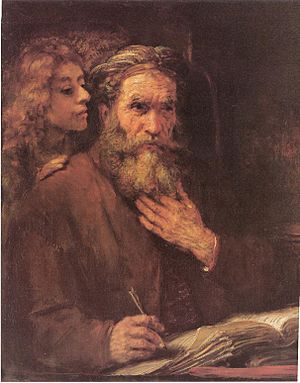
Gospels and Acts
The gospels (and Acts) are anonymous, meaning they don't name their authors within the text. While the Gospel of John might seem like an exception because the author calls himself "the disciple Jesus loved," most scholars today believe this part was added later.
Scholars generally agree that the Synoptic Gospels (Matthew, Mark, and Luke) share a lot of similar material. The common explanation, called the Two-source hypothesis, is that Mark was written first. Then, the authors of Matthew and Luke used Mark's Gospel and another possible source called the Q document. Scholars also agree that the Gospel of John was written last, using different traditions and information. In addition, most scholars believe that the author of Luke also wrote the Acts of the Apostles, making Luke-Acts two parts of one work.
Mark
Tradition and early church leaders, starting with Papias of Hierapolis, said that Mark the Evangelist, a companion of the apostle Peter, wrote this gospel. However, the gospel seems to use several older sources, which makes it less likely that it was based only on Peter's preaching. Various clues in the gospel suggest that the author wrote in Syria or Palestine for a Christian community that was not Jewish. This community had already been influenced by early Christian beliefs before Paul and then developed their own ideas separate from Paul.
Matthew
Early Christian tradition, also starting with Papias of Hierapolis, believed that the Gospel of Matthew was written in "Hebrew" (which probably meant Aramaic, the language of Judea) by the apostle Matthew, who was a tax collector and disciple of Jesus. However, most modern scholars think it's unlikely that this Gospel was written by someone who saw the events firsthand.
Modern scholars interpret Papias's tradition to mean that he believed Matthew had collected sayings of Jesus. Papias's description doesn't quite match what we know about the Gospel:
- It was most likely written in Greek, not Aramaic or Hebrew.
- It relies on the Greek Gospel of Mark and the possible Q document.
- It's not just a collection of sayings.
While the author's identity is unknown, clues in the Gospel suggest he was a Jewish male scribe from a Greek-speaking city, possibly Antioch in Syria. He likely wrote between 70 and 100 CE, using various spoken stories and written sources about Jesus.
Luke and Acts
It is generally accepted that the Gospel of Luke and the Acts of the Apostles were originally one two-part work. They were written by a single author for an unknown person named Theophilus. This author was an "amateur Hellenistic historian" who was skilled in Greek writing, which was common training for historians in ancient times.
Tradition, first mentioned by Irenaeus, says the author was Luke the Evangelist, a companion of the Apostle Paul. However, many modern scholars have doubts, and opinions are divided. Instead, they believe Luke-Acts was written by an anonymous Christian author who may not have seen any of the events described.
Some evidence for this comes from the text itself. In the introduction to Luke, the author says he used eyewitness accounts that were "handed down to us" and that he did a "careful investigation." But the author never mentions his own name or clearly states that he was an eyewitness, except in the we passages. In these we passages, the story is told using "we" (first person plural), but the author never says "I" or "me." To those who doubt an eyewitness author, the we passages are often seen as parts of an older document that were later included in Acts, or simply a Greek writing style used for sea voyages.
John
John 21:24 says the source of the Gospel of John is "the beloved disciple." From the late 100s, tradition, first mentioned by Irenaeus, identified this unnamed figure with John, the son of Zebedee. Today, however, most scholars agree that John 21 is an appendix (an extra part) to the Gospel, which originally ended at John 20:30–31.
There's a lot of debate about how and when this appendix was added, and by whom. For example, some scholars argue it was added after "the beloved disciple" had died. Most scholars date the Gospel of John to around 80–95 CE. They suggest the author used two main sources: a ""Signs" source" (a collection of seven miracle stories) and a "Discourse" source (a collection of teachings).
Epistles (Letters)
Pauline Epistles
The letters to the Epistle to the Romans, First Corinthians, Second Corinthians, Galatians, Philippians, 1 Thessalonians, and the Epistle to Philemon are almost universally accepted as being written by Paul. The titles of all these letters (except Romans and Galatians) say they are from Paul and at least one other person. This was not common in letters of that time, so it's not clear what role these other people had.
There is some support for Paul's authorship of the three "Deutero-Pauline Epistles": Ephesians, Colossians, and 2 Thessalonians. However, the three Pastoral epistles – First and Second Timothy and Titus – are probably from the same author, but most scholars who study the history of the Bible believe they were written by someone other than Paul.
Letter to the Hebrews
The Church included the Letter to the Hebrews as the fourteenth letter of Paul until the Reformation. However, scholars now generally reject the idea that Paul wrote it, and the real author is unknown.
General Epistles
The traditional authors are:
- Peter the apostle (First and Second Peter).
- The author of the Gospel of John (First, Second, and Third John), writing in old age.
- "Jude, a servant of Jesus Christ and a brother of James" (Epistle of Jude).
- James the Just, "a servant of God and of the Lord Jesus Christ" (James).
In reality, 1 John is anonymous. 2 and 3 John only identify their author as "the Elder." Although 2 Peter says its author is "Simon Peter, a servant and apostle of Jesus Christ," most scholars today believe this is a false name (pseudonymous). Many scholars hold the same opinion for James, 1 Peter, and Jude.
Revelation
The author of the Book of Revelation was traditionally believed to be the same person as both John, the apostle of Jesus and John the Evangelist, the traditional author of the Fourth Gospel. This tradition can be traced back to Justin Martyr, writing in the early 100s CE. However, most biblical scholars now believe that these were different individuals.
The name "John" suggests that the author was a Christian of Jewish background. Although he never clearly calls himself a prophet, it's likely that he belonged to a group of Christian prophets and was known as such to members of the churches in Asia Minor. Since the 100s CE, the author has been identified with one of the Twelve Apostles of Jesus. This is often linked with the idea that the same author wrote the Gospel of John. Others, however, have argued that the author could have been John the Elder of Ephesus. The exact identity of "John" therefore remains unknown.
See Also
 In Spanish: Autoría de la Biblia para niños
In Spanish: Autoría de la Biblia para niños
- Authorship of the Johannine works
- Authorship of the Petrine epistles
- Books of the Bible
- Dating the Bible
|


